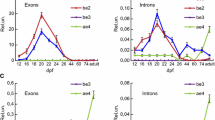Abstract
In warm-blooded vertebrates, the α- and β-globin genes are organized in domains of different types and are regulated in different fashion. In cold-blooded vertebrates and, in particular, the tropical fish Danio rerio, the α- and β-globin genes form two gene clusters. A major D. rerio globin gene cluster is in chromosome 3 and includes the α- and β-globin genes of embryonic-larval and adult types. The region upstream of the cluster contains c16orf35, harbors the main regulatory element (MRE) of the α-globin gene domain in warm-blooded vertebrates. In this study, transient transfection of erythroid cells with genetic constructs containing a reporter gene under the control of potential regulatory elements of the domain was performed to characterize the promoters of the embryonic-larval and adult α- and β-globin genes of the major cluster. Also, in the 5th intron of c16orf35 in Danio rerio was detected a functional analog of the warm-blooded vertebrate MRE. This enhancer stimulated activity of the promoters of both adult and embryonic-larval α- and β-globin genes.
Similar content being viewed by others
Abbreviations
- MRE:
-
major regulatory element
- LCR:
-
locus control region
- DMEM:
-
Dulbecco’s modified Eagle medium
References
Bernal J.D., Fankuchen I., Perutz M.F. 1938. X-ray study of chymotrypsin and hemoglobin. Nature. 141, 523–524.
Coates M.L. 1975. Hemoglobin function in the vertebrates: An evolutionary model. J. Mol. Evol. 6 (4): 285–307.
Razin S.V., Farrell C.M., Recillas-Targa F. 2003. Genomic domains and regulatory elements operating at the domain level. Int. Rev. Cytol. 226, 63–125.
Grosveld F., van Assendelft G.B., Greaves D.R., Kollias G. 1987. Positionindependent, high-level expression of the human beta-globin gene in transgenic mice. Cell. 51, 975–985.
Flint J., Tufarelli C., Peden J., Clark K., Daniels R., Hardison R., Miller W., Philipsen S., Tan-Un K. C., McMorrow T., Flampton J., Alter B., Frischauf A.M., Higgs D. 2001. Comparative genome analysis delimits a chromosomal domain and identifies key regulatory elements in the a-globin cluster. Hum. Mol. Genet. 4, 371–382.
Craddock C.F., Vyas P., Sharpe J.A., Ayyub H., Wood W.G., Higgs D.R. 1995. Contrasting effects of alpha and beta globin regulatory elements on chromatin structure may be related to their different chromosomal environments. EMBO J. 14, 1718–1726.
Tufarelli C., Hardison R., Miller W., Hughes J., Clark K., Ventress N., Frischauf A.M., Higgs D.R. 2004. Comparative analysis of the alpha-like globin clusters in mouse, rat, and human chromosomes indicates a mechanism underlying breaks in conserved synteny. Genome Res. 14, 623–630.
Klochkov D., Gavrilov A., Vassetzky Y., Razin S. 2009. Early replication timing of the chicken a-globin gene domain correlates with its open chromatin state in cells of different lineages. Genomics. 93, 481–486.
Tufarelli C., Flint J., Peden J., Clark K., Daniels R., Hardison R., Miller W., Philipsen S., Tan-Un K.C., McMorrow T., Flampton J., Alter B., Frischauf A.M., Higgs D. 2001. Comparative genome analysis delimits a chromosomal domain and identifies key regulatory elements in the a-globin cluster. Hum. Mol. Genet. 4, 371–382.
Jarman A.P., Wood W.G., Sharpe J.A, Gourdon G., Ayyub H., Higgs D.R. 1991. Characterization of the major regulatory element upstream of the human alpha-globin gene cluster. Mol. Cell. Biol. 11, 4679–4689.
Sharpe J., Chan-Thomas P., Lida J., Ayyub H., Wood W., Higgs D. 1992. Analysis of the human alpha globin upstream regulatory element (HS-40) in transgenic mice. EMBO J. 11, 4565–4572.
Anguita E., Johnson C.A., Wood W.G., Turner B.M., Higgs D.R. 2001. Identification of a conserved erythroid specific domain of histone acetylation across the alpha-globin gene cluster. Proc. Natl. Acad. Sci. U. S. A. 98, 12114–12119.
Chen H., Lowrey C.H., Stamatoyannopoulos G. 1997. Analysis of enhancer function of the HS-40 core sequence of the human alpha-globin cluster. Nucleic Acids Res. 25, 2917–2922.
Maruyama K., Ishikawa Y., Yasumasu S., Iuchi I. 2007. Globin gene enhancer activity of a DNase-I hypersensitive site-40 homolog in medaka, Oryzias latipes. Zool. Sci. 24, 997–1004.
Higgs D.R., Vernimmen D., Wood B. 2008. Longrange regulation of a-globin gene expression. Adv. Genet. 61, 143–173.
McMorrow T., Wagner A., Deryckere F., Gannon F. 1996. Structural organization and sequence analysis of the globin locus in Atlantic salmon. DNA Cell. Biol. 15 (5): 407–414.
Opazo J.C., Butts G.T., Nery M.F., Storz J.F., Hoffmann F.G. 2013. Whole-genome duplication and the functional diversification of teleost fish hemoglobins. Mol. Biol. Evol. 30 (1): 140–153.
Postlethwait J.H., Yan Y.L., Gates M.A., Horne S., Amores A., Brownlie A., Donovan A., Egan E.S., Force A., Gong Z., Goutel C., Fritz A., Kelsh R., Knapik E., Liao E., et al. 1998. Vertebrate genome evolution and the zebrafish gene map. Nat. Genet. 18 (4): 345–359.
Jared J.G., Nelson H., Trompouki E., deJong J.O., Anthony D.B., Janelle S.L., Zhiying J., Peter J.S., Weaver M., Sandstrom R., Stamatoyannopoulos J.A, Zhou Y., Zon L.I. 2012. Zebrafish globin switching occurs in two developmental stages and is controlled by the LCR. Dev. Biol. 366, 185–194.
Beug H., Doderlein G., Freudenstein C., Graf T. 1982. Erythroblast cell lines transformed by a temperature sensitive mutant of avian erythroblastosis virus: A model system to study erythroid differentiation in vitro. J. Cell. Physiol. Suppl. 1, 195–207.
Brownlie A. 2003. Characterization of embryonic globin genes of the zebrafish. Dev. Biol. 255, 48–61.
Tiedke J., Gerlach F., Mitz S.A., Hankeln T., Burmester T. 2011. Ontogeny of globin expression in zebrafish (Danio rerio). J. Comp. Physiol B. 181 (8): 1011–1021.
Author information
Authors and Affiliations
Corresponding author
Additional information
Original Russian Text © A.P. Kovina, N.V. Petrova, S.V. Razin, O.V. Yarovaia, 2016, published in Molekulyarnaya Biologiya, 2016, Vol. 50, No. 6, pp. 1020–1029.
Rights and permissions
About this article
Cite this article
Kovina, A.P., Petrova, N.V., Razin, S.V. et al. Main regulatory element (MRE) of the Danio rerio α/β-globin gene domain exerts enhancer activity toward the promoters of the embryonic-larval and adult globin genes. Mol Biol 50, 900–908 (2016). https://doi.org/10.1134/S002689331606011X
Received:
Accepted:
Published:
Issue Date:
DOI: https://doi.org/10.1134/S002689331606011X



